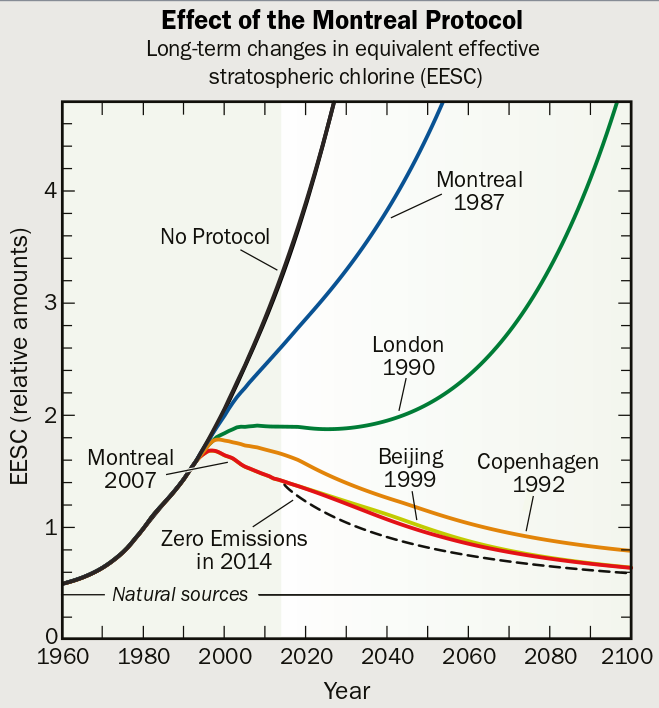Almost exactly 30 years ago a paper by Farman, Gardiner & Shanklin appeared in Nature describing the loss of ozone in the Antarctic and suggesting that the presence of chlorine compounds high in the cold polar winter atmosphere were responsible.
This finding led to international agreements to reduce the use of man-made CFCs to limit further damage – the ‘Montreal Protocol’ was signed in 1987. But, the original Protocol would only have reduced the growth of stratospheric chlorine – it took later amendments to the agreement in London (1990), Copenhagen (1992), Beijing (1999) and Montreal again (2007) to set the path towards decreasing chlorine amounts, and therefore allow the ozone to recover (see Figure 1).
In addition, as CFCs are also greenhouse gases, this restriction has reduced the radiative forcing by about 0.4Wm-2, so slightly mitigating anthropogenic climate change. The levels of global and Antarctic ozone are now starting to recover (see Figure 2), and this recovery is projected to continue over the coming century.
The fact that it took several international agreements to ‘solve’ the ozone problem is perhaps a lesson for negotiations on similar protocols for climate change more broadly?


Nice to see some chemistry here Ed! 🙂
I lecture on this and bring up the success of the Montreal Protocol (plus amendments). In broad terms, the MP “only” had to control CFC emissions: chemicals from well characterised sources, and for which alternatives were available (the US phased out CFCs from the late 70s I think). Compared to CO2, this is a doddle!
What’s interesting now are discussions on whether the MP could be used to limit gases like N2O: a GHG and ozone depleting substance (ODS) (e.g. http://www.sciencemag.org/content/326/5949/123.short). I also understand that the Parties to the MP were also discussing whether the CFC/HCFC-replacements HFCs should be regulated under the MP – not an ODS, but a powerful GHG (included in the Kyoto Protocol). …Anyway, one for all of us to chew on.
Finally, as well as ODSs being GHGs, the ozone hole itself has very likely driven a large part of recent climate change in the Southern Hemisphere. There’s a UNEP education video that covers this (and more): https://www.youtube.com/watch?feature=player_detailpage&v=AU0eNa4GrgU#t=729
Ed, when are the model runs from 1985? I couldn’t get the link to work.
Hi Rob,
Which link doesn’t work? There is a link to the report from which the figures are taken, but not the data?
cheers,
Ed.